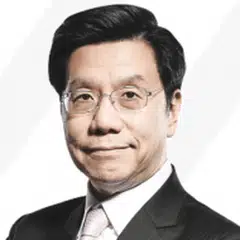Kai-Fu Lee: Five ways artificial intelligence will put China ahead

At a recent summit, I gave a speech that reviewed the development of artificial intelligence (AI) over the past years and predicted that in the coming 20 years, the combination of AI and other new technologies would bring about five major industrial changes that will allow China to lead the world in science and technology.
The changes are as follows:
1. China will lead the world in advanced manufacturing as AI empowers automation upgrades
2. China's supply chain will dominate the world as energy and material prices plummet
3. Smart cities and the Internet of Everything (IoE) will be realised and fully automatic driving will become universally accessible
4. As China's innovations in business intelligence multiply, AI will enable a new order of business operations
5. AI combined with health care innovations will lower mortality from disease and extend people's lives
Judging by the time and resources needed to produce new technologies - from exploration to application to commercialisation - I would say that there is a very high probability of these changes occurring in China in the next 20 years or so.
The following is an edited version of the speech.
Catching up with the US
In terms of realising industrial value, three years ago I predicted that China's AI would catch up with the US around 2023. I based this on a number of points:
First of all, China has a prominent talent advantage, with scientists like academician Yao Qizhi (姚期智), Professor Zhou Zhihua (周志华) and chief scientist of Sinovation Ventures Zhou Ming (周明), as well as their brilliant students.
Second, are the business model and data advantages extracted from China's huge market.
Third, are strong and pragmatic government policies supporting the AI industry.
Fourth, China's competitive startup ecosystem has given rise to strong, innovative local companies whose rapidly-growing businesses are driving similarly rapid advances in data, AI and other technologies.
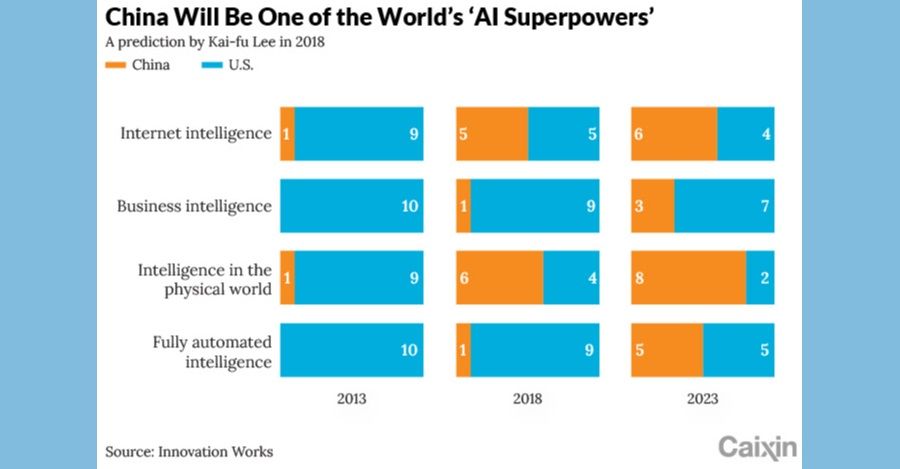
Looking back on developments over the past three years, we can already see that these predictions are coming true. There are four waves of AI currently at work reshaping every industry.
The first wave is internet intelligence. Driven by AI, internet giants such as Meituan and ByteDance have created miracles driven by their huge market and super-high market value.
The second wave is business intelligence. The application of AI in finance, insurance and other fields with a huge volume of taggable data has achieved remarkable results.
The third wave is intelligence in the physical world. The popularity of computer vision, hearing and various Internet of Things (IoT)-connected devices is empowering AI perception of the real world to rival that of humans - in some ways it even exceeds our abilities. Although applications currently employ a rather weak AI, they have nevertheless surpassed humans' capacity in certain tasks such as facial recognition, item recognition, video viewing and intelligent quality control.
One of the hottest areas these days is the fourth wave - fully automated intelligence. When AI has hands and feet, along with vision and perception, it can generate considerable value in scenarios such as unmanned driving, robotic arm gripping and drone spraying.
Of course, despite the overall development of the AI industry, concerted efforts are needed to solve some of China's hard technology bottlenecks.
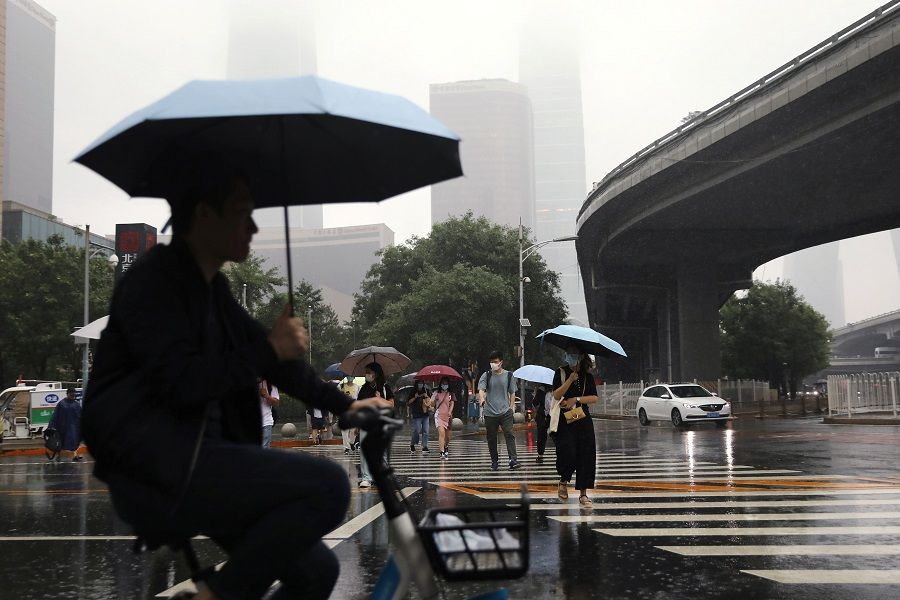
Although China may lack relevant Nobel Prize and Turing Award winners, it has been, in terms of the number of high-quality papers on AI and other key areas, quickly catching up in recent years, approaching or even surpassing the level of the US or Europe in some areas. Such advances make us very optimistic about the prospects for improving China's overall research capacity.
Prediction 1: China will lead the world in advanced manufacturing as AI empowers automation upgrades
In the past year, despite the pandemic and trade friction with the US, China successfully maintained its position as the world's factory. Still, we must admit that as Chinese labour is already twice as expensive as that of India and Vietnam, its low-cost advantage is gradually disappearing. Over time, these other countries will acquire know-how and possibly come to challenge China's status.
How to drive manufacturing upgrades while protecting labour income?
Industrial automation and intelligence will do wonders for China's manufacturing industry. What is currently accomplished by human hands, feet, eyes and brains will gradually be replaced with full automation. Automation can bring down operating costs while allowing China to maintain its advantages in production quality, process and supply chain. Chinese factories currently have the world's largest number of industrial robots, but their intelligence level is still rather low. In the future, robots will be gradually upgraded with AI and widely used in a variety of scenarios.
The companies invested in by Sinovation Ventures are not necessarily trying to replace workers. Having served as an independent director at Foxconn for many years, I understand that it's very difficult to replace the workers who make iPhones. That's because manual dexterity, hand-eye coordination and the sophisticated annual iteration of the iPhone make it very difficult to implement an automated approach. But I'll be bold enough to predict that in the following industries, we will identify some scenarios particularly conducive to automation even using today's technology.
AI has already surpassed the human eye in the field of industrial vision. Deep learning is developed with convolutional neural networks, so it is capable of accomplishing facial and object recognition as well as intelligent quality inspection - one of the "lowest hanging fruits" of AI empowerment.
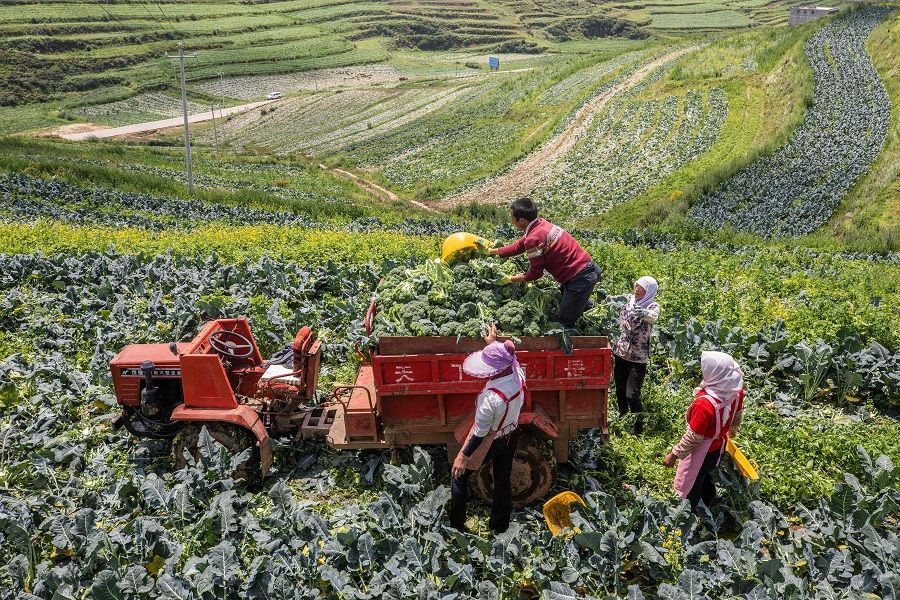
Agriculture is another "lowest hanging fruit" for AI empowerment. Drones can sow seeds, apply fertiliser and water fields with unmanned tractors. Whether a farm is growing cotton, rice or wheat, it is easier to achieve standardisation there than it is for manufacturing cell phones, shoes and so on. Once successful implementation is achieved, AI plus agriculture can thus expand globally with much greater ease.
Autonomous driving has accelerated in the wake of the Covid-19 pandemic, but Level 5 fully automated driving remains rarely seen. Nevertheless, in limited scenarios such as an unmanned factory or warehouse handling, or where human workers collaborate with robotic arms, value can be created immediately.
In the life sciences, MegaLab - another investee of Sinovation Ventures - has successfully applied AI plus automation. In the context of Covid-19, for example, its intelligent automation was applied to nucleic acid testing in hospitals, centres for disease control and laboratories, along with full automation of the post-sampling testing process.
China will be able to maintain its important position as the world's factory by applying "automation plus intelligence" upgrades for business and home.
Horizontally, industry will be the first area to see breakthroughs. China will be able to maintain its important position as the world's factory by applying "automation plus intelligence" upgrades for business and home.
It is easy for similar technology to spread from industry into the commercial sector. If technology is mature enough to automate the action of an industrial forklift, then we are also capable of making a mall security robot or a domestic housekeeping robot.
Just like human eyes and hands, robotics must also go through a process of development from simple to complex. What we must do first is direct capital to solve the industry's toughest problems. A smarter AI, having been trained by a large amount of data and undergone mass production, will enter the business field and commercial scenarios featuring end-user interaction, then finally enter homes, with different forms of derivative products.

Vertically, computer vision is a relatively easy matter, followed by relatively crude handling and moving things, and finally - the most difficult step - the simulation of hands. Progress will be made in all of these areas over the next two decades. By that time, I believe robots will be able to self-replicate, self-repair and be compatible with a variety of 3D printers. The era of future robotics will begin with the upgrading of China's automated factories before penetrating into more automated business and home scenarios.
Prediction 2: China's supply chain will dominate the world as energy and material prices plummet
The second prediction is about the energy revolution.
The cost of photovoltaic (PV) power generation has fallen to 5% of what it was 20 years ago, while the cost of lithium batteries has fallen to around 2%. Today, PV is already one of the cheapest means of generating electricity. With the expansion of new-energy vehicles, PV power will only get cheaper. Solar energy absorbed but not used is wasted. As energy storage technology is also advancing, energy can be stored in lithium batteries for later use.
In this way, electricity will become more energy-saving, environmentally friendly and easy to store. Solar and lithium battery technologies will cut the price of electricity by a quarter to a third every ten years. At this rate, in 20 years, the cost of electricity will only be a tenth of what it is today.
When the day comes for a change in the way that energy is produced, which country will have the best advantage?
In the past, countries with oil, coal mines and natural gas reserves had a natural advantage. But today, as solar or wind plus lithium battery technologies mature, and given the abundance of solar or wind energy in the world, it will be countries with the strongest manufacturing capabilities and industrial capacities that take the lead.
Progress in new materials will push the energy revolution yet further, while synthetic biology and many other technologies will bring the cost of production significantly down. In the agricultural sector, the determining factor will shift from cultivation and harvesting capacity to supply manufacturing capacity. Countries with strong manufacturing will thus lead the way in agriculture as well.
Reaching this era of abundance, however, will require manufacturing strength at the world-factory level. And whether or not China can lead the world to such an era depends on the degree and speed of automation and intelligent upgrades, with AI, big data and other platform-level technologies as the new underlying infrastructure.
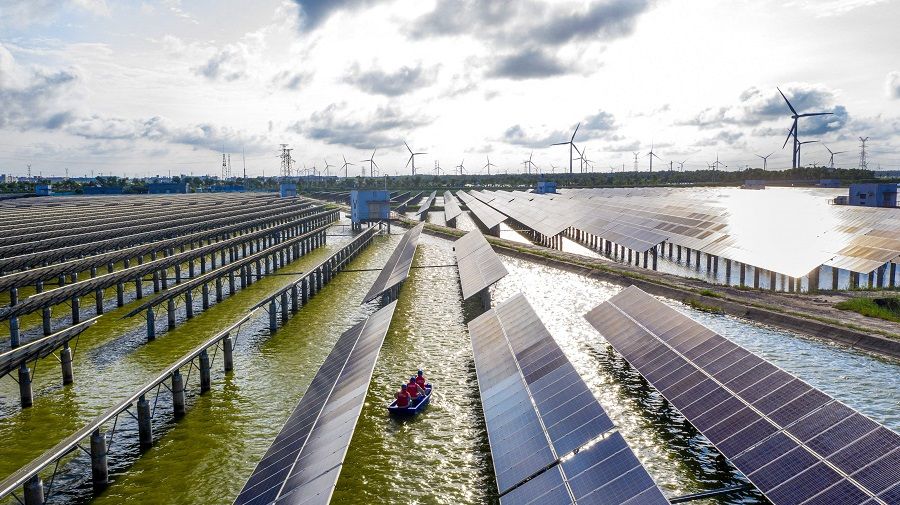
In the future, vertical farming will be a key "breadbasket" for human subsistence. Vegetables and fruit will be grown in factories, soil-free, on vertically stacked planters. Emerging technologies such as plant-based meats and stem cells can create the food of the future without harming animal life.
In the foreseeable future, the materials and energy required to produce a new item will become cheaper and greener, manufacturing will be completed by fully automated robots and mankind will enter an era of abundance, never to see poverty or hunger again. Reaching this era of abundance, however, will require manufacturing strength at the world-factory level. And whether or not China can lead the world to such an era depends on the degree and speed of automation and intelligent upgrades, with AI, big data and other platform-level technologies as the new underlying infrastructure.
Prediction 3: Smart cities and the Internet of Everything will be realised and fully automatic driving become universally accessible
The third prediction is the realisation of smart cities and the IoE, along with the popularisation of fully automated driving.
I divide the era of fully automated driving into two phases:
The first stage is its realisation in simple, specific scenarios to pave the way for commercialisation. For example, we can start with automatic forklifts in warehouses, then fixed-route shuttle buses and minibuses, followed by taxis. When these scenarios are realised, we will be in the Level 4 stage of autonomous driving.
The next stage is Level 5, fully automated driving. In this stage, automated driving can replace humans in all traffic scenarios and conditions.
This day may come in just 20 years. How can we accelerate the process? The key is building smart transportation and smart cities.
Recently, a brand-new technology has been applied to some new highway projects in Jiangsu province: in the dark or poor weather conditions, automatic ground lights and sensors help charge new-energy vehicles. These are the kinds of methods that can help speed the arrival of smart transportation and smart cities.
What, then, will prompt the birth of the next great operating system? I think it is likely to be fully automated driving.

When it comes to autonomous driving, attitudes in Europe, the US and China diverge quite sharply. In Europe and the US, people are simply thinking about how to get self-driving cars on the road while leaving the roads and cities themselves unchanged. China, meanwhile, has a strong openness to the new technology revolution as well as powerful modes of execution. People here are questioning why the roads and the cities must remain the same. Why not let the highway "talk" to the car? Why not layer cars and pedestrians from under to above ground in new urban centres, totally avoiding vehicle-pedestrian collisions and accelerating the arrival of Level 5 autonomous driving?
Once the era of unmanned driving is here, it will be matched with an epoch-making operating system (OS). How did the past few generations of OS come about? The Windows OS emerged with the application of PC computer software, while iOS and Android OS emerged with the rapid global popularisation of smartphones after 2015. Once an OS takes off, it spreads to reach each corner of the world. What, then, will prompt the birth of the next great operating system? I think it is likely to be fully automated driving. That's because, in order to achieve fully automated driving, we need to be able to integrate AI, multiple sensing technologies, hardware and software communication and operational decisions in a very powerful computing environment combining local, remote and cloud computing.
Such an OS is incredibly difficult to realise, but once it has been, our vehicles will have "eyes, hands and feet" and be able to "hear, walk and move" like a person.
Once autonomous driving reaches this level, two things will follow. First, massive amounts of data will be opened up, allowing for higher-function AI calculations; second, the scale of automated car production will expand, thus bringing down the cost of required components. The price of LIDAR, for example, will drop substantially in 20 years. Eventually, the cost of building a smart car will come down, along with the price of building a robot, and the reduced costs will be conducive to autonomous driving's full-scale popularisation. In the not-so-distant future, you will be able to operate a self-driving plus robotic OS at a reasonable price.
Prediction 4: As China's innovations in business intelligence multiply, AI will enable a new order of business operations
The fourth prediction is an innovative breakthrough in business intelligence (BI) in China. Future BI is about the understanding of human language - not just language recognition, but the actual understanding of text's content.
There are four layers of data intelligence: at the bottom is fragmented and unstructured data, and above that, an upper layer of information that "reads" the data content. Most deep learning today uses these "data and information" layers.
The third layer, "knowledge," is currently used in mapping and relational chains, but most of this is yet to be applied to AI. The highest layer is "insight", where intelligent analysis and assisted decision-making based on events and insights can offer users recommendations. However, this fourth layer is far from perfect.
We believe that the future of BI lies in the top layers - that is, in "knowledge and insight".
Features enhanced by search engines, along with "knowledge and insight" refined by AI and big data, have the potential to forge the future's new business order.
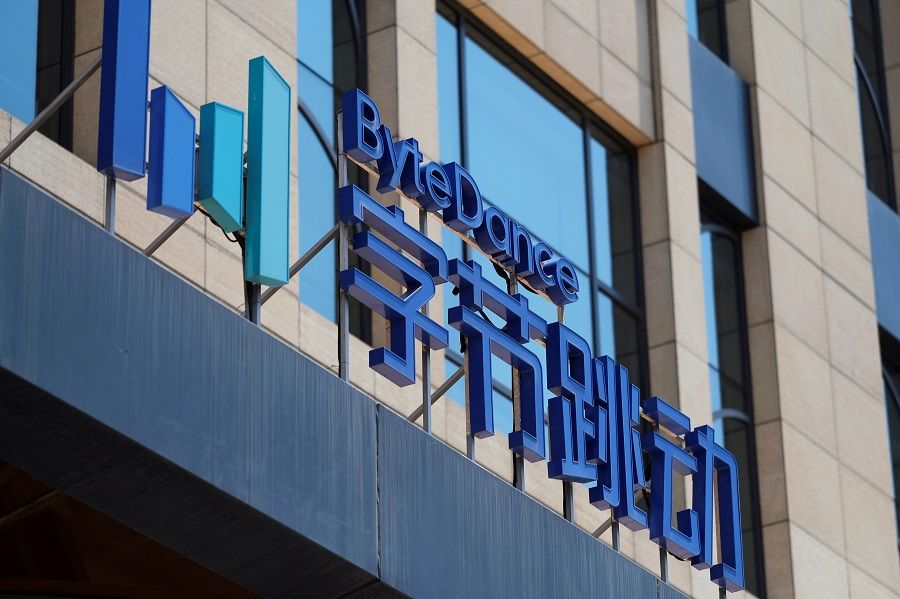
"Personalisation" is one of AI's strengths. Today, for example, short video app Douyin provides "personalised services" by constantly recommending videos to individuals based on their past viewing behavior. Taobao, the e-commerce site, meanwhile, is able to constantly recommend products that match users' preferences. But why is AI "personalisation" only for existing videos, and not new ones? If generating new videos is too difficult, we can start by trying to create "personalised" text. For example, if the user likes cute Japanese styles, upon understanding their emotions, needs and use scenarios, AI can work as a beauty marketing consultant, making recommendations for the user specifically.
Another scenario is "financial event understanding". Today's finance is highly digitalised, with risk control and money laundering measures, but is it possible to take things to the next level? For example, what should we invest in when we know for sure that the global pandemic recedes in about two months? What stocks should I sell if I know the Panama Canal is blocked for another three weeks? These are the questions major financial investors are asking every day. Features enhanced by search engines, along with "knowledge and insight" refined by AI and big data, have the potential to forge the future's new business order. Therefore, the big data and AI revolutions, which are only getting started, should be formatted and intellectualised to offer true "insights."
Prediction 5: AI combined with health care innovations will lower mortality from disease and extend people's lives
At present, the life sciences are undergoing huge changes worldwide and medical data is rapidly being digitised. In addition to the popularity of wearable devices, certain medical processes such as AI viewing, gene sequencing and other new technologies are bringing structure and standardisation to massive amounts of new data. Data, the necessary fuel for AI development, will certainly bring better and more plentiful opportunities for innovative medical applications of AI.
For example, today we usually only talk to a doctor for five minutes when we visit the hospital, but there is a huge amount of data hidden in those five minutes. If a doctor, with the help of AI, could collect every detail, they could make a "personalised" diagnosis and treatment plan to optimise the process, reduce costs and improve efficiency.
In addition to the use of AI and big data to offer "personalised" treatment, we will see big opportunities for the universal application of surgical robots and use of AI to invent new drugs.
In the future, AI may bring two huge changes to pharmaceuticals: the first is a major reduction in the costs and time involved in pharmaceutical production...The second change is "personalised" treatment plans.
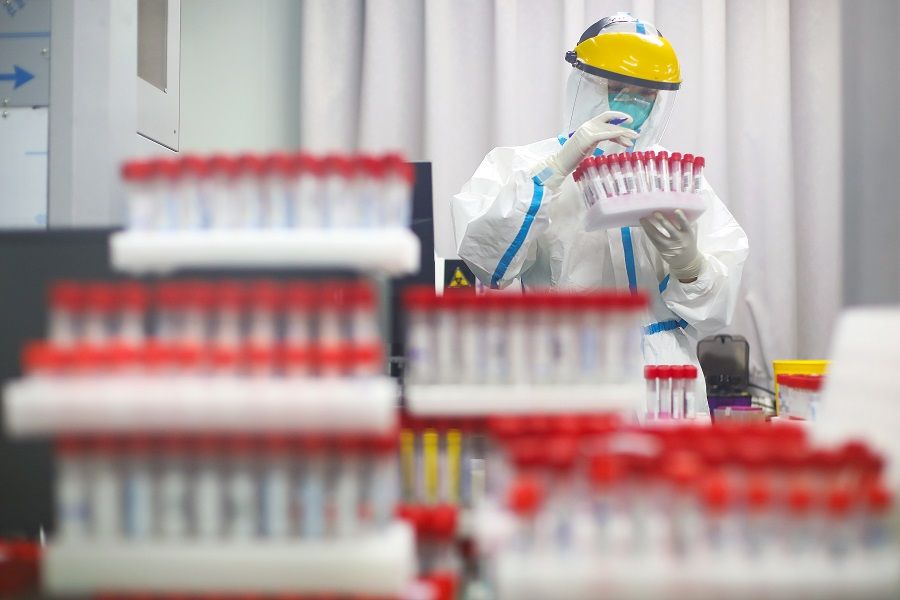
In the future, AI may bring two huge changes to pharmaceuticals: the first is a major reduction in the costs and time involved in pharmaceutical production. It currently costs US$2 billion to make a medicine, but in the future, the cost is expected to drop to a tenth of that figure. Nowadays, high costs are making pharmaceutical companies reluctant to develop drugs for rare diseases. But the aforementioned AI-supported drug discovery process from Insilico Medicine dramatically reduces the time it takes to develop traditional drugs in the pre-clinical stage - from four to five years to 18 months - which in turn greatly reduces time and cost investments involved in drug discovery! In the future, AI can significantly accelerate the development of new drugs and relieve more patients' ailments.
The second change is "personalised" treatment plans. Why does everyone use the same medicine when they get sick? Using traditional pharmaceutical methods, it costs US$1 billion to US$2 billion to manufacture a drug, from the R&D to the clinical stage. In the future, we will be able to make a drug with just US$100 million to US$200 million. When that happens, more drugs will be available to support personalised therapeutic treatments. Seeing how China has embraced and invested in new health care technologies, the country is expected to lead the industrial transformation of AI and health care.
Conclusion
If the US could become a global hegemon by succeeding in leading in four key sectors of the industrial revolution - energy, manufacturing, transportation and health care - a century ago, then today, China is well-poised to maintain its position as the "world's factory" by virtue of its advantages in big data, AI, automation and intelligent production capacity. As mentioned above, manufacturing advantages are what drive energy revolutions and changes in agricultural supply; thus, once manufacturing becomes stronger, energy, agriculture and future new materials are likewise strengthened in turn. Today, AI and health care is on a fast track for development, while new technologies such as synthetic biology will present real opportunities.
These five predictions may be only part of the story. But there is no doubt that China, the "world's factory", stands to be a major player in the next two decades of global industrial change and generate enormous value for the whole world.
This article was first published by Caixin Global as "Weekend Long Read: Five Ways AI Will Put China Ahead". Caixin Global is one of the most respected sources for macroeconomic, financial and business news and information about China.
Related: China's going full speed ahead on technology innovation. Will it work? | Beijing's tech conundrum in 2021: How to bolster tech sector while reining in the digital giants | Has China surpassed the US in the 5G race? | China's strides in technology good for US and the world | A whole new world with the Internet of Things

